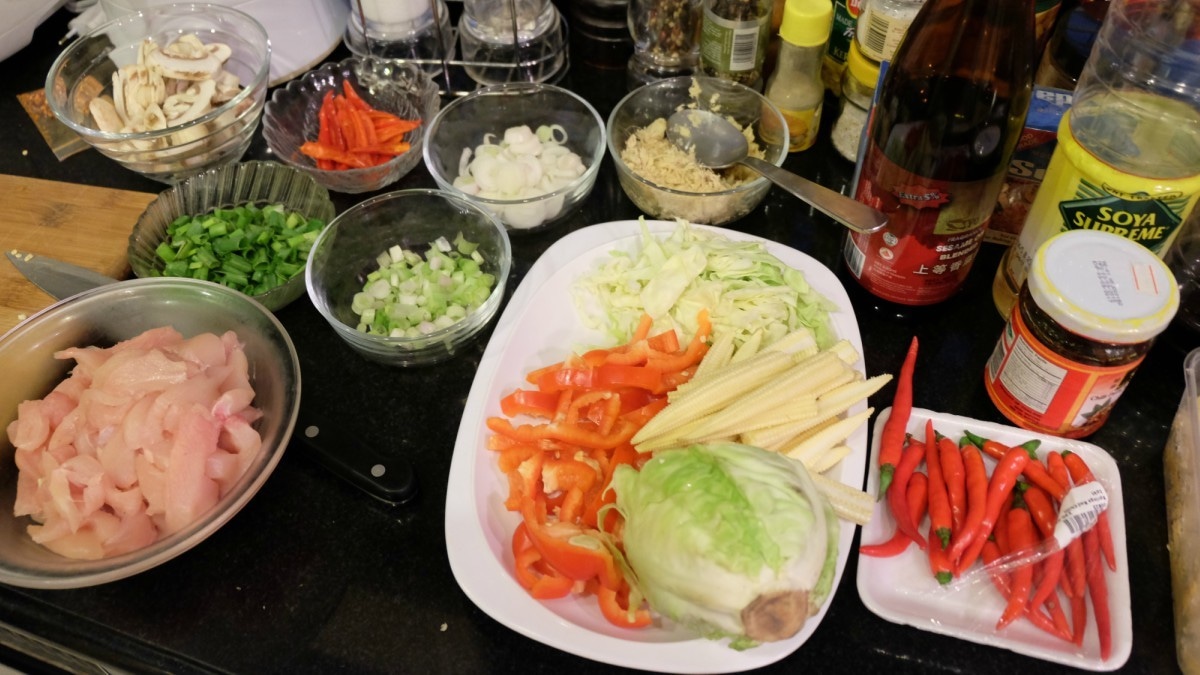Here's how to make the perfect Asian chicken wok fry
Chinese food in popular culture has a place of its own. Growing up immersed in ‘90s American TV, pop-culture food references captured my imagination. To my sheltered eyes, nothing stood out more than a bunch of unassuming white boxes, masking seemingly universally loved flavors.
The North American box of Chinese food; many of you will know what I’m talking about. These boxes were like the gold of El Dorado—highly sought after, the stuff of dreams, and getting my hands on them would take years.
No surprises therefore that when I moved to Canada , my mission was to find these bad-boys and live out an experience I had seen multiple times in movies or television.
I lived near Koreatown. Around me were the usual bits of Canadiana: Tim Horton’s, Mr. Sub, something called Jimmy the Greek. At night, the cool fall evenings bought hordes of fun-seeking customers to the many Karaoke bars around my neighborhood. Unsurprisingly, Chinese restaurants abounded as well.
Imagine my horror, when my first-ever delivery from a Chinese restaurant turned into an experience I would never want to relive.
The prawns were cooked in a sickly pale sauce with large, tasteless vegetables. The beef was non-spicy; the chicken, a General Tao variant, was sweet. And, the most unpardonable crime of all, the food was served in aluminum take-home boxes. Not square. Not white. Not at all what I had imagined.
Surely, I reasoned, I just ordered from the wrong type of place. Perhaps this was just a bad experience and I needed to look elsewhere. Another failed attempt or two later, I sadly realized that the Hakka-type Chinese food I was used to in Karachi was a far cry from what actually constitutes Chinese food.
And I wasn’t probably the only one who had such an experience. Due to China's vastness, cuisines vary across regions, depending on the availability of ingredients, spices, livestock or seafood.
Szechuan flavors with their spiciness are renowned worldwide; Hunan flavors kick it up even further. Both rely heavily on the blend of peppers and garlic as a base. Alternatively, Guangdong province does away with the spice and focuses on flavor, relying more on scallions, ginger and garlic. What I was served was bland, depressing and not what my imagination had created a desire for.
Luckily, with a plethora of Asian convenience stores around me, there seemed only one probable option: cook it myself. And so I invested in a variety of Asian sauces and seasonings, including the most important tool of my arsenal: the Wok.
Woks are available in a variety of sizes, shapes (round or flat-bottomed) and in varying compositions such as carbon steel, cast-iron, aluminum and the like, including the modern Teflon-coated kind.
The history of the Wok is mired in mystery. The first recorded instances of its use stem from China during the Han dynasty, approximately between 200 B.C to 200 A.D. Some maintain that soldiers needed convenient cooking vessels and used their own helmets.
Others maintain that the Mongols needed cooking vessels during their massive conquests to quickly feed soldiers on the go, hence spreading it wherever they dominated. Their long handles enable cooking on high heat and stirring foods from a distance. Their deep base encourages flavors to blend and cook together with intensity. They are portable and require little fuel to use. In Cantonese, Wok means cooking pot.
They are a staple of Asian cuisines due to their versatility of usage, from everything to a stir-fry to braising, deep frying, steaming, roasting…you get the picture. Even our own desi karhais showcase this cooking vessel’s prevalence around the subcontinent.
And flavour is what I want! As I think about what I was trying to accomplish back then, wandering between Asian stores, deciphering strange characters on sauce bottles, the quest for the perfect flavour kept me going, a desire for a heart-warming connection, blending my expectations from the past with a new future of home-cooked food. It jump-started a journey and a love for food that has remained ever since.
And that’s what we are going to cook today; a simple, Chinese wok-fry, made with household ingredients, blending together an easily available mix of sauces and seasonings that can be replicated or altered. Herein lies the fun of cooking with a wok where no two dishes need to be similar.
This is a technique that has taken me years to modify and alter as my palate and cooking abilities matured. It’s easy, lots of fun and very, very, flavorful.
Ingredients
400 grams chicken, thinly sliced, or two breasts
½ medium cabbage, thinly sliced
About 2 cups baby corn, sliced length-ways

About 2 cups mushrooms, sliced vertically
1 whole red bell pepper, sliced
5-6 red chilies deseeded, sliced vertically
Seasonings or oils
2 tablespoons vegetable or canola oil
2-3 spoons soy sauce, to taste

1 tablespoon oyster sauce
1 tablespoon red chili paste
2 spoons sesame Oil - (1 in beginning and 1 midway)
Salt/pepper to taste
Rice
Bring 3 cups basmati or brown rice to a boil in 8 cups salted water. When almost complete, drain water and set aside for serving.
Optional Additions
Bok Choy (2-3 stems, added toward the end) Cashews (lightly pan-fried separately, then tossed in later) Lime (a drizzle at the end before serving)
Method
Prep time: 20 minutes
Cooking time: 8-10 minutes
Serves 3-4 persons.
To begin with, we cut our chicken breasts into small strips, large enough not to become dry over a hot flame. Garlic and ginger are chopped very finely or ground into a paste. The spring onions are chopped in three sections; the bottom, the middle and the green leafy stalks.

Blend the oils over a medium-high flame and once hot enough, toss the chicken in. Vegetable or canola oil are important as their burning temperatures are high. The sesame oil coats the chicken in a pleasant flavor.
Stir and toss until the chicken whitens on all sides and then add the garlic, ginger and spring onion bases. Fry and a short while later, add the chopped red chilies, salt and soy sauce.

Reduce the heat to medium so that nothing burns but everything should still be bubbling. Add the red chili paste, oyster sauce and spring onion mid-pieces. Mix well.
As you see the sauce separating from the oil, add the red bell pepper, mushrooms, cabbage and baby corn. These items should be cooked until they are edible but not droopy. You will want to maintain a certain level of crunch, so fresh ingredients are recommended over canned.
Add salt and a little black pepper to taste, and when almost finished, add the remainder of the leafy spring onion stalks. Turn off the heat and let everything simmer, stirring occasionally. Spoon over rice or noodles, or mix directly in the wok and serve.

This is a simple dish and it’s all down to timing. You want to let the flavor of the garlic and ginger dominate the base, you want excessive heat from the spices and you want the mixed flavors of the sesame oil, spring onions and soy sauce.

Though it has taken me time and years to perfect this technique, I still wish I could throw it in a white food box, and take it all in.













Comments